SALTWATER CHRONICLES FLY FISHING ADVENTURES IN SALTWATER (part 13)
| Sysadmin Note |
|---|
| Part 12 can be found here |
Taking A Break with Largemouth Bass
There is no doubt that Florida offers some of the greatest saltwater fly fishing found anywhere in the world. The saltwater fishing can be so overwhelming that it is easy to forget that Florida also has excellent fishing for largemouth bass. In 1975 the largemouth bass became the freshwater fish of the State of Florida. I know anglers that never fish the saltwater here in Florida because they are consumed with the excitement of fly fishing for largemouth bass. Besides there are days when the wind can drive you from the salt flats and the fishing for the other freshwater species of gamefish can offer a pleasant change of pace and it fun and exciting in its own right.
Largemouth Bass [Micropterus salmoides floridanus] (Florida Sub-Species) has several common names which includes bass, American black bass, bayou bass, bigmouth bass, marsh bass and there are several others to describe this eating machine with fins and gills. Largemouth bass are one of the most widely distributed fish species in the world. In many places where they were not native, they were imported due to their popularity as a sport fish. The original range was the eastern half of the United States, the spread of the largemouth bass is a testament to its ability to adapt to a variety of habitats.
The following is some basic information on the habits of bass. They live in all types of water including swamps, ponds, lakes, reservoirs, creeks and large rivers and can even be found in estuaries. They prefer weedy environments and are seldom found in water over twenty feet. In the spring of the year bass migrate to shallow water that warms earlier than the deeper water to feed and select a nesting site. The spawning in Florida goes on between February and March depending on the weather cycles as it effect the water temperature as they prefer 64 to 70 degrees.
The males choose the nesting sites and then they attract the females. Shortly after the eggs are deposited the females leave for the casinos and shopping malls and the males defend the nest, during this period the males are fasting and this period last from three to seven days. Upon hatching the fry are transparent and are around 3mm in length. At first they will hang around the nest absorbing the yoke and then they rise in schools to feed on zooplankton. When they are 6 to 6.5mm long they change color to pale green with black lateral line markings. The young will continue to school as they grow and they are both prey and predator and will basically feed on anything that doesn't eat them.
As they grow larger the schools begin to drift apart and during the day they cruise under the lily pads, through the weedbeds and around the structures seeking to ambush their prey. During the hours of darkness they move to deeper water often laying on the bottom resting and logs, trees and brush piles.
In an historical sense the most noted American author to chronicle the life history and fishing methods for Bass was James A. Henshall who published Book of Black Bass in 1881 and More About Black Bass in 1889. Henshall is often referred to as the Father of American Bass Fishing, he embraced all methodd which included fly fishing and also had Mary Orvis Marbury tie some of his bass flies. It is interesting to note that 43% off all freshwater anglers in America are fishing for largemouth bass!
Florida has long been known for its great largemouth bass fishing and places like the world famous Lake Okeechobee are famous for their excellent bass fishing. As a side note, did you know the Lake Okeechobee is the 7th largest fresh water lake within the lower forty eight States?
To be a successful in your endeavors to fly fish for bass the beginning angler must first understand a little bit about the Largemouth Bass and how it feeds, when it feeds and what it feeds on.
Regardless of the water you have chosen to fish, if it holds largemouth bass the local bait shop will be able to tell you what the bass are likely going to be eating. This, coupled with your own observations, should allow you to come up with suitable flies.
If you have little or no knowledge on fly fishing for largemouth bass and wish to do a little homework then I recommend reading Largemouth Bass Fly-Fishing, Beyond the Basics by Terry and Roxanne Wilson published in 2001. The Fly Fisher's Guide to Warmwater Lakes by Cliff Hauptman published in 1995 and Fly Fishing Bass Basics by C. Boyd Pfeiffer published in 1997. All three of these small books will offer excellent insight into the world of fly fishing for Largemouth Bas
I will now offer a few important tips on the tackle used for fly fishing for bass that I have learned over the years. I believe in using fly rods that are suitable for the intend task, therefore my basic fly rod for bass is a nine foot rod for an eight weight line. The two fly lines that I use the most are a floating weight forward line and a ten foot type III sink tip fly line. I also carry a type III full sinking line for fishing in deep water during cooler water temperatures.
I have taken largemouth bass on six and even four weight rods when fishing for bluegill or other smaller warmwater species but when I am targeting largemouth bass I use an eight weight system and I will have both a nine weight and ten weight rod available to throw the largest of the deer hair or popper style surface patterns which are very air resistant.
Another point that I would like to emphasize is that long casts beyond forty feet is of little use, as you are working around weed beds, lily pads, brush piles, down timber and the like, so short accurate cast are much more productive. Furthermore, trying to throw long cast with air resistant flies is something I do not care to do!
The leaders you choose are also important as they should be designed to turn over the patterns you are using and an undersized leader will not allow you to be accurate. My leaders for floating fly lines are nine foot in length with tippets of 10, 12, or 15 pound test. Remember you will be fishing around weed beds, lily pads and the other structures already mentioned and you will need these heavier tippets to stand the strain of fighting these dynamic and exciting fish. When using the sink tip fly lines the leader I use are generally around six feet in length unless I am using the Pop- Up Method as describe in an earlier article published here.
Largemouth Bass are a known freshwater species but often I have caught them in the upper reaches of the St. Sebastian River in the brackish water. On one outing we caught several largemouth bass, small snook and Mangrove snapper along the banks of a channel, you never can tell where a largemouth bass will show up.
Now I will share a few of my favorite largemouth bass patterns with you, but realize there are thousands of effective bass flies out there and many of them are also used for trout or in the saltwater.
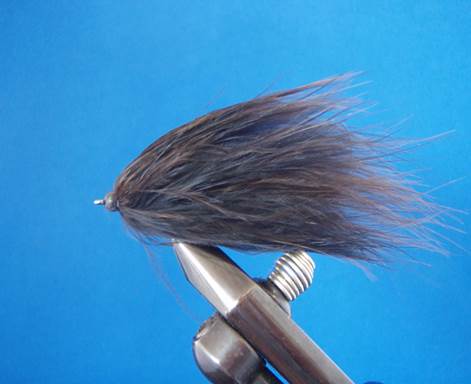
BH B & B Marabou Leech
- Hook: Dai Riki #810
- Size: 1/0-6
- Thread: Dark Brown or Black 6/0 or A
- Bead: Black Tungsten 5/32 for size 6, or sized to hook
- Tails: Black and Dark Brown Marabou Mixed
- Body: Black Marabou, Brown Marabou, wrapped
I also tie this pattern in Brown and Dark Olive & Brown. This pattern is easy to construct and very effective on many warm water species. I also tie some smaller sizes for Panfish on Tiemco 105, Sizes 4-8.
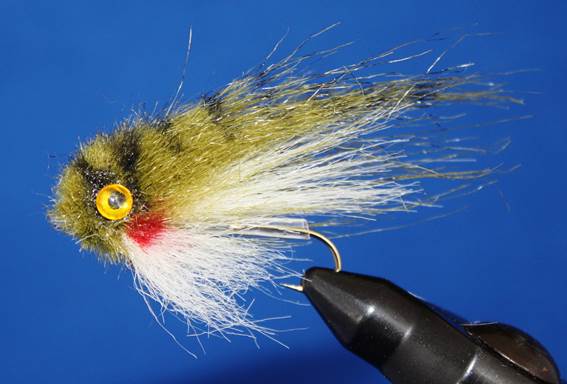
Barred Olive CF Tube Streamer
- Hook Only Flies: Dai-Riki 930 Sizes: 3/0 to 8
- Tube: Clear, 3/32 Diameter
- Hook: Dai-Riki 155 Size: 8 or 10
Note: For larger diameter tubes, use larger hooks. However, I strongly suggest staying with wide gape short shank hooks.
If you desire to tie this pattern straight to a hook, then I suggest Dai-Riki 930 Size: 3/0 to 8 or Dai-Riki 810 Size: 3/0 to 6 depending on the size of the imitation you desire. - Thread: White A or Olive A
- Body/Wing: On the bottom of the tube place a small amount of Cream Craft Fur. Then on the top of the tube place another bundle of Cream Craft Fur. If desired, place any Krystal Flash or Flash-A-Bou on top of the Cream Craft Fur. Then place a larger bundle of Olive Craft Fur on the top.
- Gills: Take a Red Sharpie marker and color in gill at the base of the throat area.
Important tying note: Craft Fur is much like deer hair; when you cut off bundle from the hide, comb out the under-fur so to speak. Save the combed out material as it is use forming the head and can also be used as dubbing. - Head: Formed by stacking and packing the shorter fibers of the Olive Craft Fur that you combed out. Once the head is complete, whip finish and trim into the desire shape with scissors.
- Eyes: Mix up some 5 Minute Epoxy and take a toothpick and work the epoxy into the area where you want the eyes to go. Place the Yellow with Black Center 3-D Eyes on either side in the appropriate position and squeeze. If you get a little epoxy on your fingers, just clean them off with a little alcohol. Once the epoxy begin to set up, give the eyes one more squeeze.
- Barring: Using a Black Sharpie Marker, bar the head and the olive part of the Body/Wing.
Note: If I want an imitation that goes deeper on its own, I will use painted lead (or other) Dumb-Bell Eyes; thus foregoing the use of epoxy.
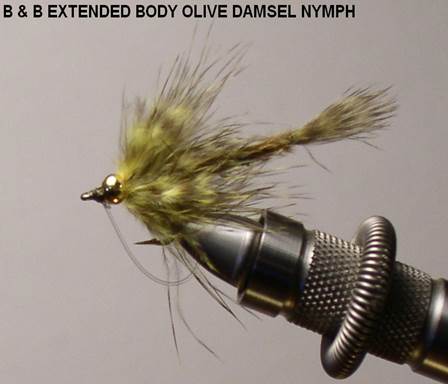
B&B EXTENDED BODY OLIVE DAMSEL NYMPH
- Hook: Tiemco 105 Sizes: 6-10
- Thread: Olive dun, 8/0
- Weed guard: Two loos of 0x mono [optional]
- Bead: Metal – gold or copper as desired
- Body Extension: Body extension is tied on a length of 0x tippet material strung between two vises.
- Tails: Yellow/olive grizzly Marabou tips
- Body: Barred chartreuse Marabou fibers tied in by the tip and twisted with thread and wrapped forward. [Several bodies can be done at one time] After you finish spiraling the thread touch it and the mono with a drop of Super Glue and begin you next body. They can be cut apart and attached to the hook.
- Thorax and legs: Wrapped, two or three yellow/olive grizzly Marabou feathers to the base of the bead.
NOTES: This pattern is durable and has a great life-like swimming motion. It can be tied in many different color combinations to match the color of the naturals in your area.
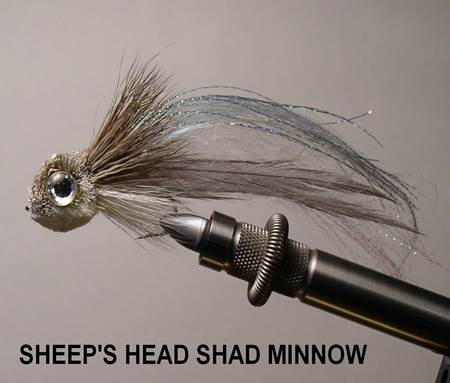
SHEEP'S HEAD SHAD MINNOW - Dave Whitlock Pattern
- Hook: Tiemco 8089 OR 8089NP Sizes: 2-6-10-12
- Thread: White or Gray, 8/0 and 'A'
Tying Note: 8/0 thread can be used to tie the body, however, A thread should be used for the collar and head – the hook shank should be roughened and then use zap-a-gap and then thread should be applied as a tying base. - Body Foundation: Mono equal to the diameter of the hook wire and should be tied down on either side of the hook shank and the body should begin even with the hook point
- Body/Tail: Ten strands of pearl Krystal flash and white Icelandic sheep hair tied on both the top and bottom of the hook shank
Ten strands of silver motion Mylar, a strip of wide pearl tinsel tied down on either side of the body. Two lite dun hackle feathers, one per side. - Gills: Dubbed, Scintilla #32 vivid red
- Topping: Ten strands of peacock Krystal flash
- Collar and Head: Deer hair – white on top and gray on the bottom. Use the natural tips for the collar and then flare the hair to finish the head. When trimming the head remember to make it narrow.
- Eyes: Black and white doll eyes place with epoxy. 3-D black with silver prism background also works well
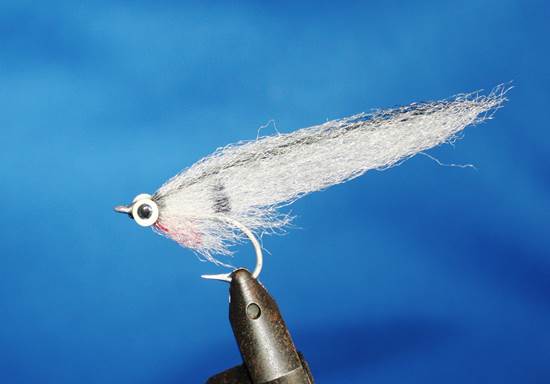
Shad Minnow
- Hook: Mustad 3407 Sizes: 1/0-6
- Thread: Light Dun 6/0
- Wing/Body: Silver/Grey EP Fibers, with six to eight strands of Silver Flash-A-Bou, with another thin Bunch of Silver/ Grey Fibers on top and the add two strand of Pearl Flash-A-Bou topped with a thin bunch of Mullet EP fibers and finished off with another small bunch of Silver/Grey EP Fibers. The body should be marked with a black bar about one inch behind the head with a Black Sharpie marker.
- Belly: Silver/Grey EP Fibers, marked with red slashes on either side of the throat area using a red Sharpie marker
- Eyes: Pearl White with Black centers 3D eyes, applied on either side of the head with five minute epoxy
This is a pattern of my own design which has work well for a number of years. In any water that hold shad the Bass will find them and feed on them. With any of the warm-water patterns a weedguard can be added as explained in other patterns.
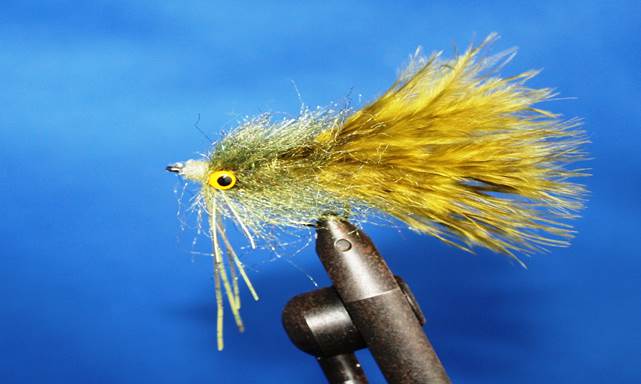
Mottled Olive Bushy Bug
- Hook: Dai-Riki 810 Sizes: 2/0-6
- Thread: Olive Dun 6/0
- Weedguard: 20 Pound Mason Hard Monofilament
- Eyes: Dumb-bell Type, Yellow with Black Center
- Tails: Olive Marabou, Barred with a Black Sharpie
- Body: EP Olive Dubbing Brush with legs, wrapped
- Legs: Four Olive Sili-Legs with Black Flecks
- Head: Dubbed, UV Light Olive
This is my favorite crayfish imitation and I also tie this pattern in tan with brown mottled markings.
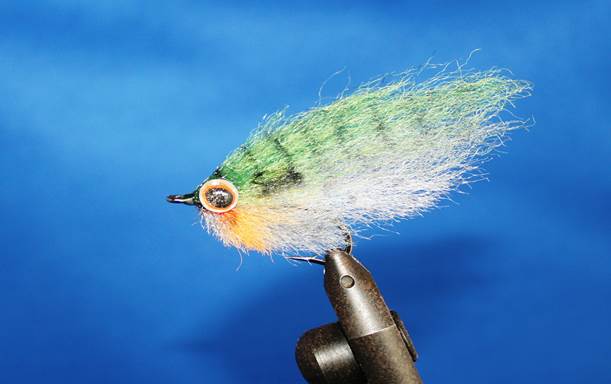
Bluegill Minnow
- Hook: Dai-Riki 810 Sizes: 3/0-6
- Thread: Grey 6/0-8/0
- Weedguard: 20 Pound Mason Hard Monofilament, Optional
- Wing/Body: Silver Gray EP Fibers with Gray EP Fibers on top and two bunches of Olive EP Fibers
- Belly: Gray EP Fibers follow by Orange EP Fibers followed by another bunch of Gray EP Fibers
- Eyes: 3D Orange with Black Center, applied with Epoxy.
Gills & Body Marking: Using Sharpie Markers, Red Gill Slashes on either side at the base of the Gray and Orange, Faint blue shading on the Grey EP Fibers, Black Barring on the Olive EP Fibers and a large back dot behind the eye on either side of the body.
Once all the EP Fibers are applied to the hook, comb out the imitation and trim to shape.
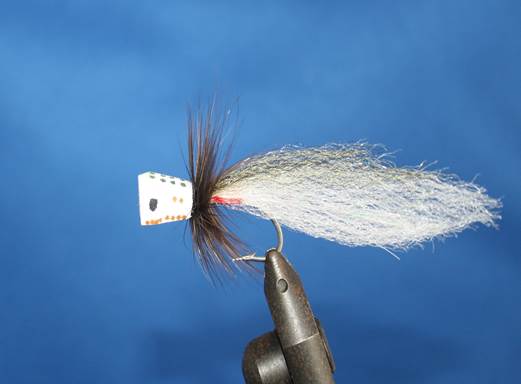
Foam Popper White Barred
- Hook: Mustad 34007 Sizes: 2/0-6
- Thread: White A
- Weedguard: Optional 20 Pound Mason Hard Monofilament
- Wing: White EP Fibers, topped with a small bunch of Mullet EP Fibers with a red Slash on the bottom of the white wing at the base of the hackle
- Hackle: Two dark dun hackles, wrapped
- Head: White Foam, styled and colored as desired
Notes: The are many different popper and slider styles of dry cell foam popper heads and they come in a variety of colors and all of them work at one time or another.
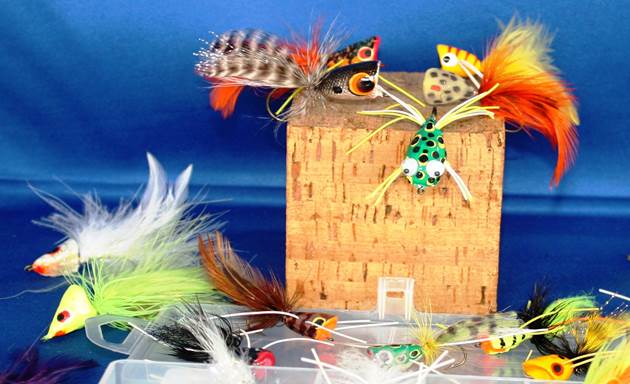
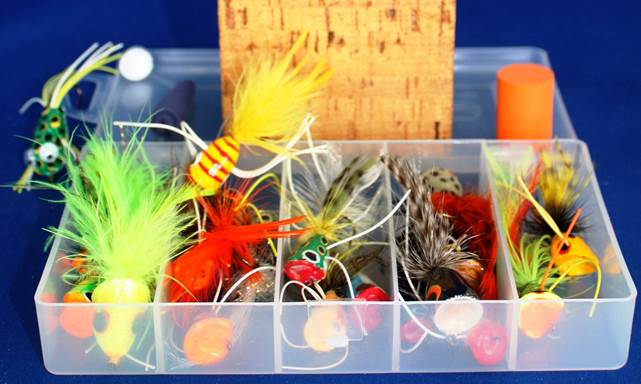
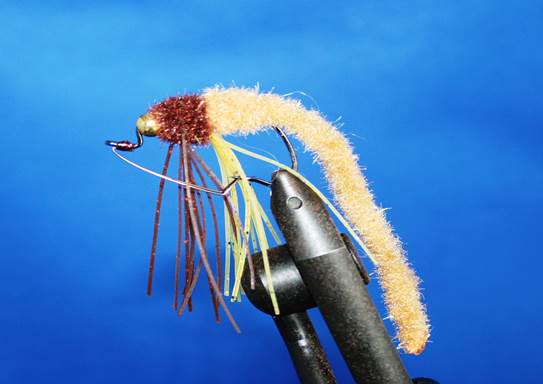
Tan Bass Worm
- Hook: Gamakatsu G-Lock Worm Hook Sizes: 4/0-2
- Thread: Tan 6/0
- Bead: Gold Metal
- Body: Tan Antron Chenille, melt the tip
- 1st Set of Legs: Chartreuse Sili Legs Six to Eight
- Thorax: Brown Antron Chenille
- 2nd Set of Legs: Pumpkin Sili Legs Six to Eight
- Weed Guard: 30 lb mono or 25 lb steel wire formed with pliers
I also tie the worm in Brown, Light Brown, Black, Purple and Chartreuse.
Enjoy & Good Fishin'
| Sysadmin Note |
|---|
| Part 14 can be found here |
